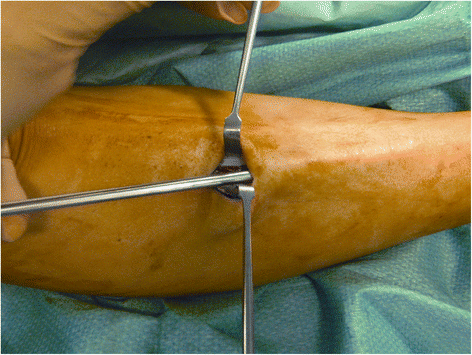What is Compartment Syndrome?
Compartment Syndrome is a serious medical condition that occurs when excessive pressure builds up inside an enclosed muscle space in the body, often after an injury. This pressure impairs blood flow, depriving muscles and nerves of necessary oxygen and nutrients, which can lead to permanent damage if not treated promptly. The body’s muscles are grouped into compartments, surrounded by tough membranes called fascia. When swelling or bleeding occurs within a compartment, the fascia doesn’t expand, leading to increased pressure.
A Fasciotomy is a surgical procedure performed to relieve pressure in a muscle compartment. It involves making one or more incisions through the skin and fascia to release the tension and restore normal blood flow and tissue function. It is a life- and limb-saving procedure for individuals with acute compartment syndrome.

Symptoms of Compartment Syndrome
Recognizing the signs early is crucial. Symptoms can vary based on the severity and location but commonly include:
- Severe pain that does not improve with medication
- Pain that worsens with stretching the muscle
- Tingling, burning, or numbness
- A feeling of tightness or fullness in the muscle
- Swelling, firmness, and discoloration
- Decreased range of motion
Weakness or paralysis in severe cases
Procedure / Treatment: Fasciotomy
If acute compartment syndrome is suspected, immediate surgery is required. The treatment steps generally include:
Diagnosis – Confirmed through clinical assessment and, in some cases, by measuring intra-compartmental pressure.
Surgical Intervention – Fasciotomy is performed under general anesthesia. Long skin and fascial incisions are made to open the affected compartments.
Post-Surgical Care – The wound may be left open for several days to allow swelling to subside, followed by delayed closure or skin grafting.
Rehabilitation – Physical therapy is needed to restore strength and function.
Types of Fasciotomies
Fasciotomies are categorized based on the affected limb:
- Lower Leg Fasciotomy – Common in trauma or fractures; involves releasing anterior, lateral, deep posterior, and superficial posterior compartments.
- Forearm Fasciotomy – Often done for crush injuries or severe burns.
- Thigh Fasciotomy – Less common, usually needed in high-energy trauma or vascular injuries.
- Foot or Hand Fasciotomy – Performed in localized crush injuries or burns in small compartments.
Prevention of Compartment Syndrome
While not all cases are preventable, certain steps can reduce risk:
- Immediate treatment of fractures and injuries
- Avoiding overly tight bandages or casts
- Monitoring swelling after surgery or trauma
- Prompt medical attention for unusual pain or limb symptoms
- Careful fluid management in trauma cases
Benefits of Fasciotomy
- Prevents permanent muscle and nerve damage
- Saves limbs from amputation
- Restores normal blood flow and tissue health
- Improves long-term functionality and mobility
- Reduces complications like infections, chronic pain, and disability
